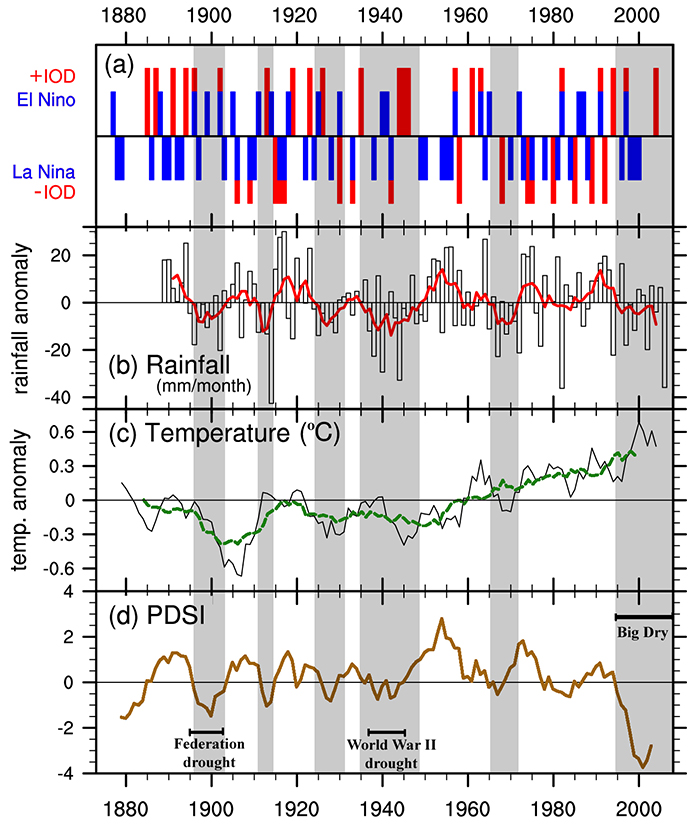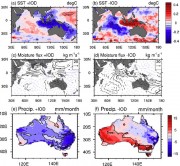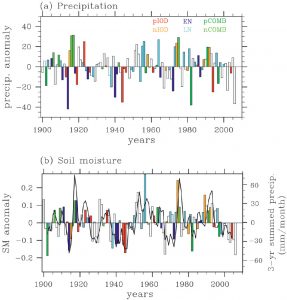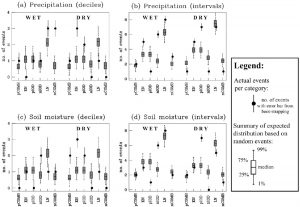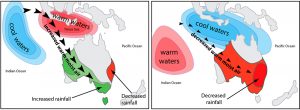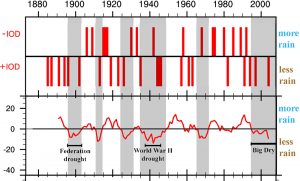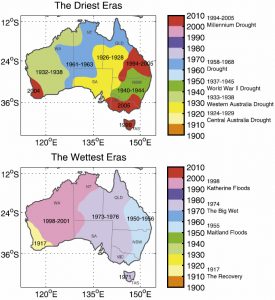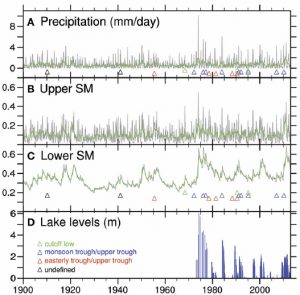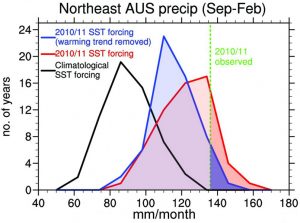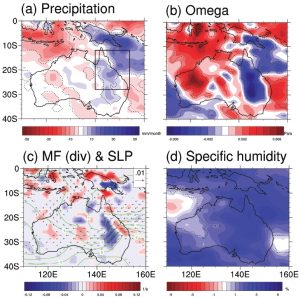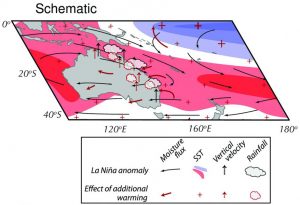Droughts and Floods in Australia
The Big Dry and other iconic droughts
At the turn of the millennium, a large region of Australia was gripped by the most severe drought in living memory, the “Big Dry.” The ramifications for affected regions were dire, with acute water shortages for rural and metropolitan areas, record agricultural losses, the drying-out of two of Australia’s major river systems and far-reaching ecosystem damage. Yet the drought’s origins had remained elusive.
For Southeast Australia, Ummenhofer et al. (2009) show that the “Big Dry” and other iconic 20th Century droughts are driven by tropical Indian Ocean variability, not by Pacific Ocean conditions as traditionally assumed.
In particular, a conspicuous absence of characteristic Indian Ocean temperature conditions that are conducive to enhanced tropical moisture transport has deprived southeastern Australia of its normal rainfall quota. In the case of the “Big Dry”, its unprecedented intensity is also related to recent above-average temperatures.
Pacific Ocean variability is dominated by the well-known El Niño-Southern Oscillation (ENSO) phenomenon. Similarly, the leading mode of tropical Indian Ocean variability, the Indian Ocean Dipole (IOD), is a coupled ocean-atmosphere mode characterized by sea surface temperature anomalies of opposite sign in the east and west of the basin with an associated large-scale atmospheric re-organization.
To assess the relative importance of the IOD and ENSO for Southeast Australian drought, all years for the period 1889 to 2006 are classified as to the state of the Indian and Pacific Ocean. The “Big Dry” is apparent post-1995, characterized by severe drought conditions. Since 1995, four La Niña events failed to break the drought. El Niño and positive IOD events are associated with drier conditions. However, neither pattern occurred more frequently than normal. In contrast, there has been a complete absence of negative IOD events throughout this latest drought period, with the last negative IOD occurring in 1992. Negative IOD events bring anomalously wet conditions to the Southeast and their absence deprives the region of its normal rainfall quota.
Ummenhofer et al. (2011) found a distinct asymmetry in the impacts of the opposite phases of both ENSO and IOD on Australian rainfall and soil moisture. There are significant differences between the dominant drivers of drought at interannual and decadal time scales. On interannual time scales, both ENSO and the IOD modify southeastern Australian soil moisture, with the driest (wettest) conditions over the southeast and more broadly over large parts of Australia occurring during years when an El Niño and a positive IOD event (La Niña and a negative IOD event) co-occur.
Lower-frequency variability over southeastern Australia, however, including multiyear drought periods, seems to be more robustly related to Indian Ocean temperatures than Pacific conditions. The frequencies of both positive and negative IOD events are significantly different during periods of prolonged drought compared to extended periods of ‘‘normal’’ rainfall. In contrast, the frequency of ENSO events remains largely unchanged during prolonged dry and wet periods.
Floods in Australia – the role of ocean warming
Australia experienced extreme rainfall during the 2010/11 La Niña event. Rainfall across the northeast was 84% above average, and soil moisture conditions were unprecedented since 1950. This extreme rainfall event was associated with severe flooding in northeastern Australia which claimed dozens of lives and caused billions of dollars in damages. In Ummenhofer et al. (2015) we demonstrate that the warmer ocean background state increased the likelihood of the extreme rainfall response.
The unusually wet 2010/11 season in Australia led to an observable drop in global sea level, as large amounts of water were temporarily shifted from the ocean onto Australia. In addition, record global terrestrial carbon uptake was driven by unusually high vegetation growth after the widespread wet conditions in the interior of the Australian continent, which included a rare filling of Lake Eyre (Pook et al. 2014).
These extreme hydroclimatic conditions coincided with a strong La Niña in the Pacific. While La Niña events are typically associated with wet conditions in the northeast, the severity of the conditions encountered across eastern Australia in 2010/11 were unusual even for a La Niña. Long-term ocean warming has made the oceans surrounding northern Australia about 0.5°C warmer than 60 years ago. Our study aimed to quantify if and by how much this long-term ocean surface warming contributed to the hydroclimatic extremes and ensuing flooding across northeast Australia during 2010/11.
Using a suite of atmospheric general circulation model experiments based on 2010/11 ocean conditions with and without long-term warming, we identify the mechanisms that increase the likelihood of extreme rainfall: additional ocean warming enhanced onshore moisture transport onto Australia with increased ascent and precipitation over the northeast. Thus, both dynamic and thermodynamic atmospheric changes contributed to the 2010/11 Australian extremes.
Our results highlight how ocean warming influences rain-producing atmospheric circulation conditions by providing additional moisture and changing circulation patterns. This increases the likelihood of extreme precipitation for Australia during La Niña events. Given continued warming it is likely that La Niña’s could be associated with increasingly extreme rainfall in the future.
Using a series of climate model experiments, Taschetto et al. (2016) explore whether prolonged extended extreme wet and dry periods in Australia can arise from internal atmospheric and land variability alone. They find that ocean feedback processes increase the magnitude of Australian rainfall variability by about 30% and give rise to more spatially coherent rainfall impacts. However, oceanic variability may be less important than previously assumed for the long-term persistence of Australian rainfall anomalies. This poses a challenge to accurate prediction of long-term dry and wet spells for Australia.
Further information
Denniston RF, Villarini G, Gonzales AN, Wyrwoll K-H, Polyak VJ, Ummenhofer CC, Lachniet MS, Wanamaker AD, Humphreys WH, Woods D, and Cugley J. (2015). Extreme rainfall activity in the Australian tropics reflects changes in the El Nino-Southern Oscillation over the last two millennia. Proceedings of the National Academy of Sciences, 112, 4576-4581. Reprint
Pook MJ, Risbey JS, Ummenhofer CC, Briggs PR, and Cohen T. (2014). A synoptic climatology of heavy rain events in the Lake Eyre and Lake Frome catchments. Frontiers in Environmental Science, Special Issue on “Circulation weather types as a tool in atmospheric, climate and environmental research”, 2, 54, doi: 10.3389/fenvs.2014.00054. Reprint
Rathore S, Bindoff NL, Ummenhofer CC, Phillips HE, and Feng M. (2020). Near-surface salinity reveals the oceanic sources of moisture for Australian precipitation through atmospheric moisture transport. Journal of Climate, 33, 6707-6730. Reprint
Rathore S, Bindoff NL, Ummenhofer CC, Phillips HE, Feng M, and Mishra M. (2021). Improving Australian rainfall prediction using sea surface salinity. Journal of Climate, 34, 2473-2490. Reprint
Taschetto AS, Sen Gupta A, Ummenhofer CC, and England MH. (2016). Can Australian multiyear droughts and wet spells be generated in the absence of oceanic variability? Journal of Climate, 29, 6201-6221. Reprint
Ummenhofer CC, England MH, McIntosh PC, Meyers GA, Pook MJ, Risbey JS, Sen Gupta A, and Taschetto AS. (2009). What causes Southeast Australia’s worst droughts? Geophysical Research Letters, 36, L04706, doi:10.1029/2008GL036801. Reprint
Ummenhofer CC and Sen Gupta A. (2009). Why the Big Dry? Australasian Science Magazine, 30 (5), 28-29.
Ummenhofer CC, Sen Gupta A, Briggs PR, England MH, McIntosh PC, Meyers GA, Pook MJ, Raupach MR, and Risbey JS. (2011). Indian and Pacific Ocean influences on Southeast Australian drought and soil moisture. Journal of Climate, 24, 1313-1336. Reprint
Ummenhofer CC, Sen Gupta A, England MH, Taschetto AS, Briggs PR, and Raupach MR. (2015). How did ocean warming affect Australian rainfall extremes during the 2010/2011 La Niña event? Geophysical Research Letters, 42, 9942-9951. Reprint

